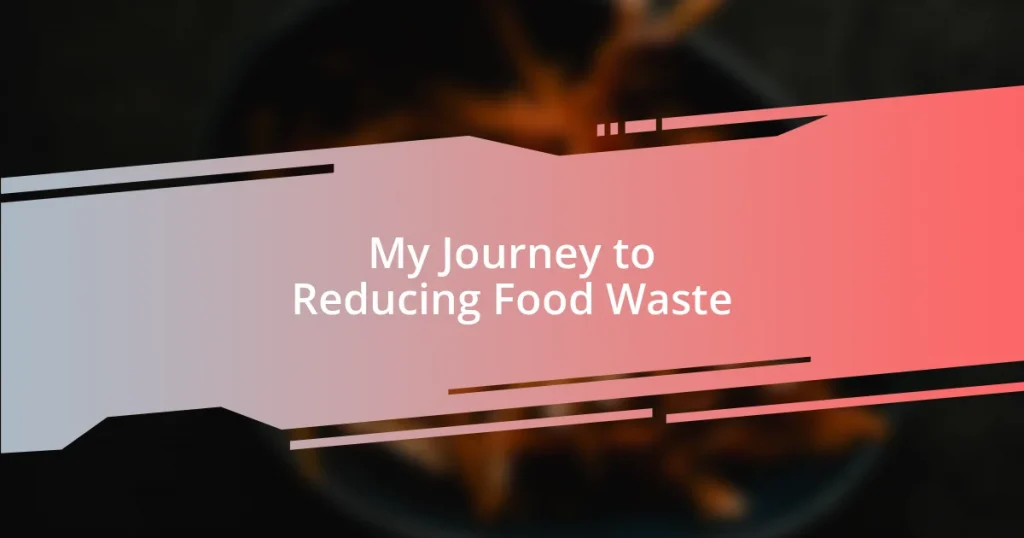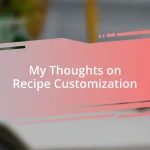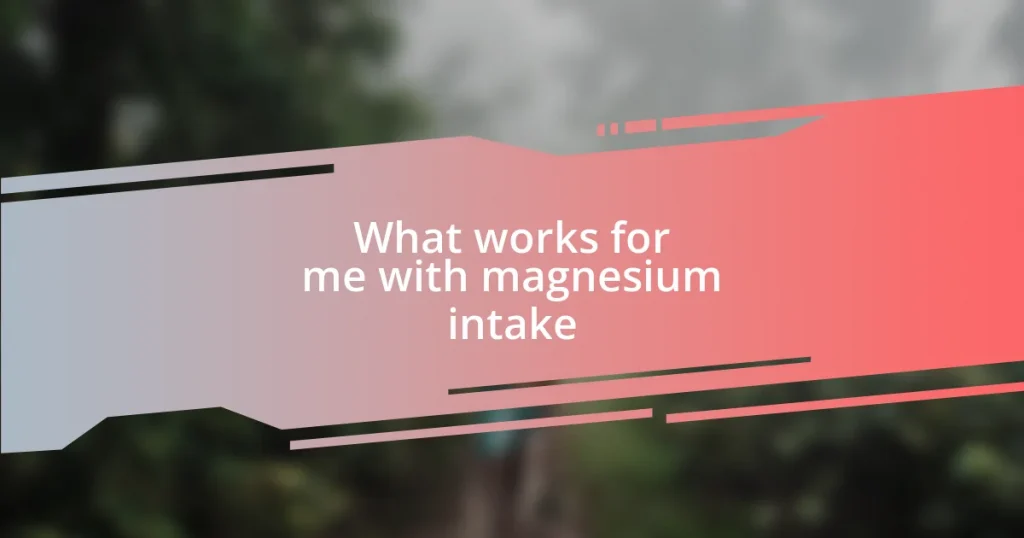Key takeaways:
- Understanding food waste issues starts with awareness of expiration dates and changing cultural habits around waste.
- Implementing practical strategies like meal planning, tracking waste, and repurposing leftovers can significantly reduce food waste.
- Sharing successes and experiences with others fosters community engagement and inspires collective action towards sustainable practices.
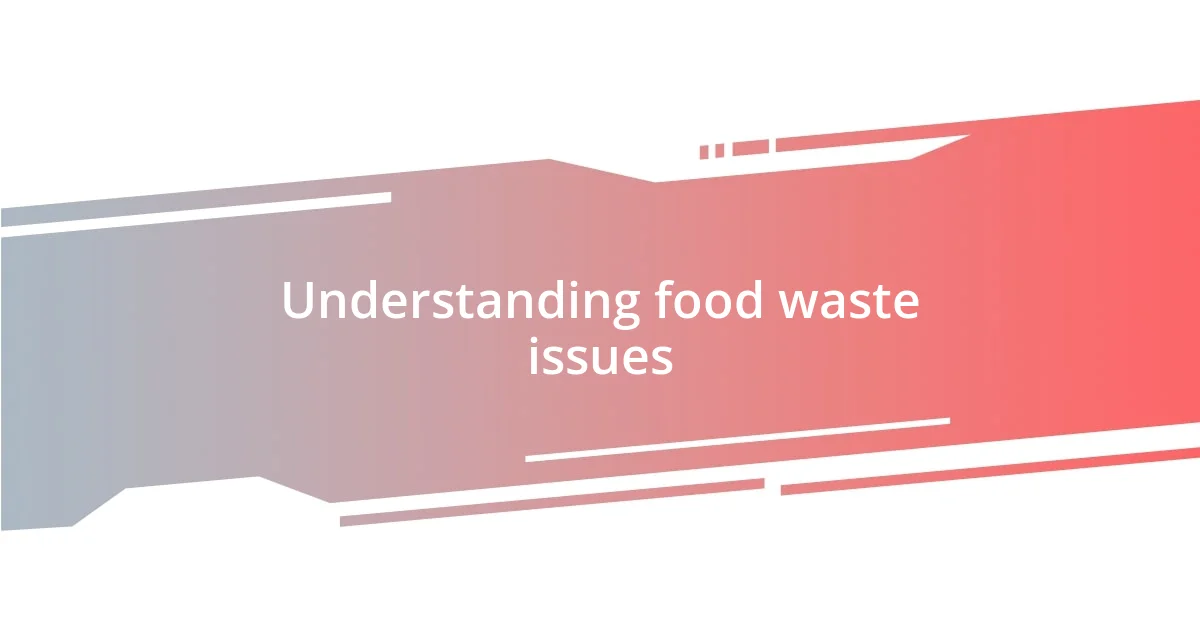
Understanding food waste issues
It’s staggering to think that roughly one-third of all food produced globally is wasted. As I started reflecting on my own habits, I recalled a time when I unconsciously tossed out perfectly good leftovers simply because they didn’t look appealing. How many of us have focused more on aesthetics than on the real value that food brings, both nutritionally and environmentally?
I’ve noticed that a lot of food waste stems from misunderstanding expiration dates. When I began to truly study these labels, it shocked me to find out that “sell by,” “use by,” and “best before” dates often don’t mean what we think they do. Has anyone else felt that lingering hesitation to eat something past its “best before” date? It turns out that a little knowledge can empower us to make better choices while saving perfectly edible food.
Culturally, we’ve built habits around waste that can be hard to break. I remember hosting a dinner party where I cooked enough for an army, ultimately tossing out an embarrassing amount of food. I realized it wasn’t just about the meal, but also how our expectations can lead to a cycle of waste. So, what if we started changing these mindsets? Each small step can lead to a much larger impact on reducing food waste.
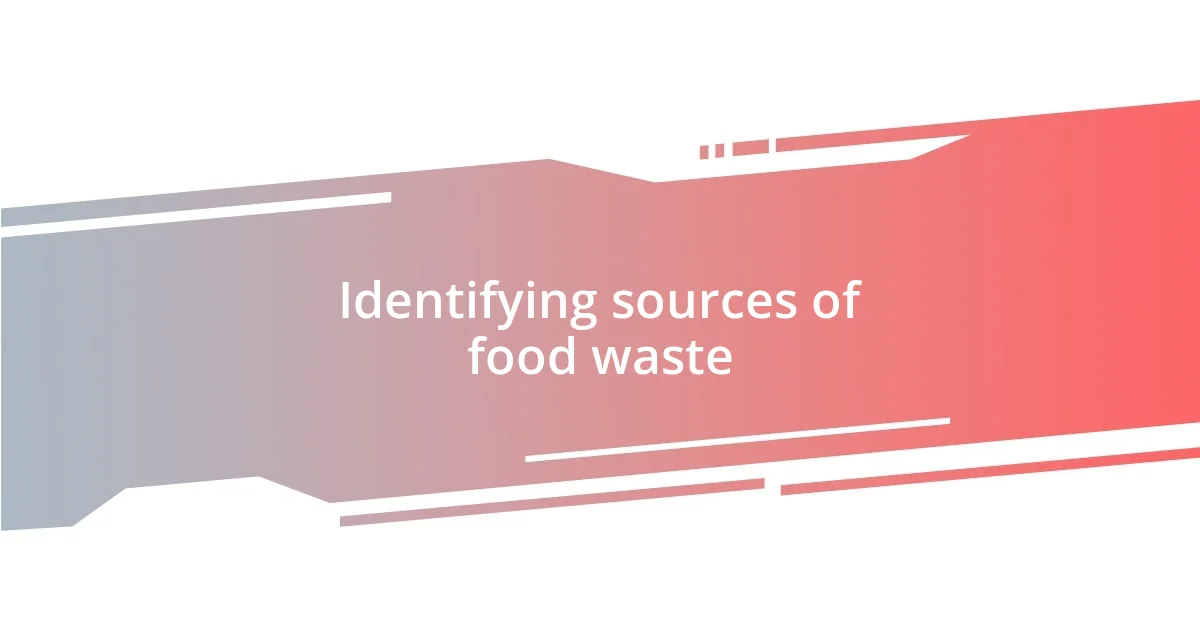
Identifying sources of food waste
Identifying sources of food waste requires a closer look at our shopping and cooking habits. I remember the shock of cleaning out my fridge one day, uncovering items I had forgotten about—some barely touched, others past their prime. It made me realize how often I buy groceries without a clear plan. This pattern isn’t uncommon; we often shop with a mindset of abundance, leading to excess that ultimately finds its way to the trash bin.
Here are some common sources of food waste I’ve identified in my journey:
- Overbuying: Buying in bulk can seem economical, but it’s easy to go overboard.
- Lack of meal planning: Without a meal strategy, ingredients tend to accumulate without a purpose.
- Improper storage practices: Not knowing how to store different types of produce can accelerate spoilage.
- Neglecting leftovers: I’ve often forgotten about takeout containers lurking in the back of my fridge. They served as reminders that leftovers deserve a second chance.
- Unintended vision of perfection: I’ve learned that a slightly bruised apple or a vegetable with a bit of discoloration can still be delicious and nutritious—something I wish I had embraced earlier.
Reflecting on these sources encourages me to rethink my choices and prioritize reducing waste where I see it most often.
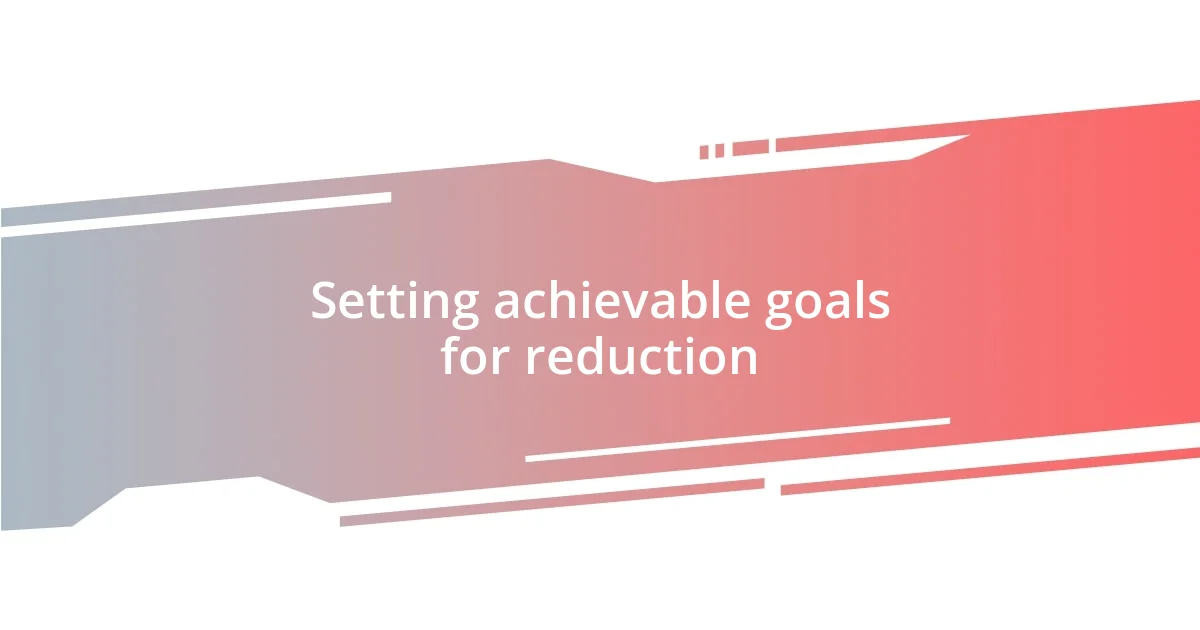
Setting achievable goals for reduction
Setting achievable goals for reducing food waste starts with understanding what is realistic for you. When I first embarked on this journey, I set out to reduce my food waste by half within a month. While that goal felt ambitious, it turned out to be overwhelming. Instead, I discovered that breaking it down into weekly targets—like using leftovers creatively or composting scraps—made a huge difference. Baby steps can lead to substantial change.
I’ve also learned the importance of tracking progress. I kept a simple journal documenting what I threw away each week, and to my surprise, it illuminated patterns in my waste. This isn’t just about numbers; it’s about growing awareness and refining habits. Are you aware of what you waste the most? Once I identified that, I could set a clear goal to either buy less of those items or figure out new ways to incorporate them into my meals.
Establishing a supportive community around these goals can elevate your efforts. I started discussing my objectives with friends and family, and their feedback often sparked fresh ideas. I remember swapping recipe ideas with a friend who had similar goals. Each shared success—and even setbacks—made the journey feel less lonely. And that sense of connection? It transformed my experience from a singular goal into a collaborative mission.
| Goal Type | Example |
|---|---|
| Short-term Goals | Use up leftovers twice a week |
| Medium-term Goals | Reduce grocery shopping by 20% |
| Long-term Goals | Aim for zero food waste in 6 months |
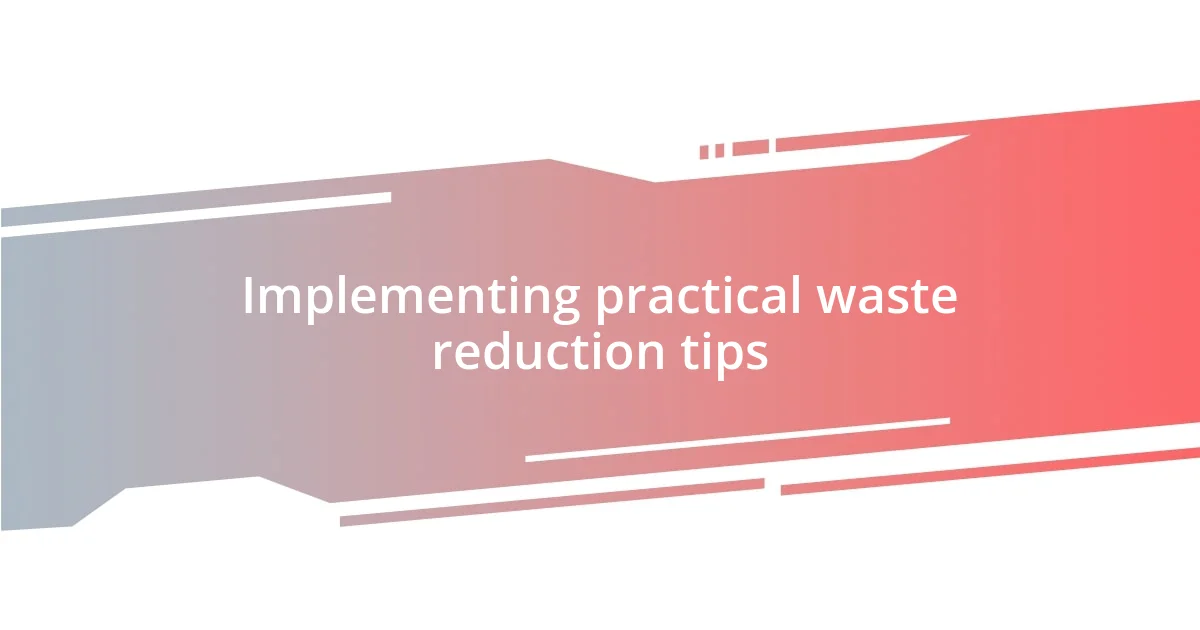
Implementing practical waste reduction tips
Implementing practical waste reduction tips can transform how we approach our kitchens and shopping habits. One of the simplest yet effective strategies I adopted was creating a detailed shopping list before heading to the store. I fondly recall that feeling of empowerment as I walked down the aisles, knowing I was armed with a plan. This not only minimized impulse buys but also focused my purchases on what I truly needed—and trust me, the satisfaction of using up everything on that list is immense.
Another impactful tip I learned is to repurpose leftovers creatively. One evening, after cooking a big batch of roasted vegetables, I turned the remnants into a savory frittata. Not only did it feel like I was giving those ingredients a second chance, but it also became a family favorite. Have you ever thought about how easy it is to transform last night’s dinner into a new meal? Finding joy in these little culinary experiments has made me appreciate what I have and reduce waste significantly.
Finally, I discovered the importance of storage strategies. Early in my journey, I often tossed away wilted greens and soft fruits simply because I didn’t know how to store them properly. After learning the art of wrapping herbs in damp paper towels or keeping fruits in a humidity-controlled environment, I felt like I had unlocked a secret level in my food preservation game. Isn’t it fascinating how small changes can lead to such big wins? With these practical tips in hand, I’ve turned waste reduction into a routine that feels both fulfilling and exciting.
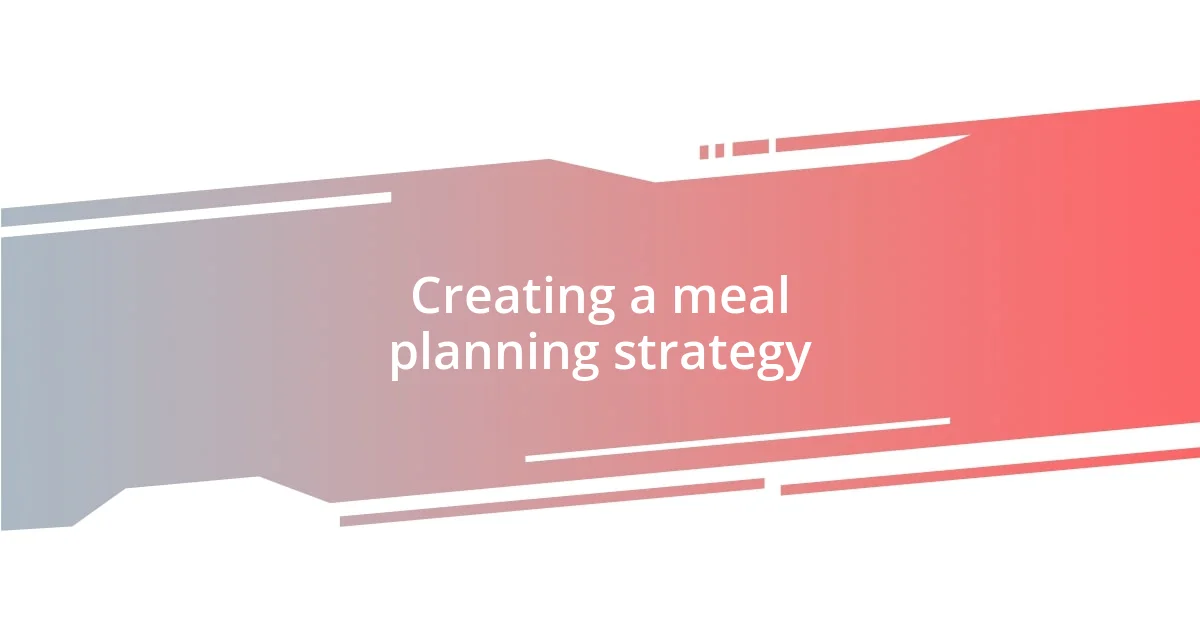
Creating a meal planning strategy
Creating a meal planning strategy can be a game changer in reducing food waste. I remember the first time I sketched out a week’s worth of meals; it felt a bit daunting, but once I got into the groove, it changed everything. I’d sit down with my favorite cookbook or browse online for inspiration, carefully selecting recipes that used similar ingredients. How many times have you found produce wilting in your fridge because you didn’t plan around it? I made it a mission to ensure every item I bought had a purpose, which not only cut back on waste but also made my cooking more enjoyable.
Another aspect that I found effective was batch cooking. I often choose one or two days each week to prepare larger quantities of meals, like soups or casseroles. The anticipation of having ready-to-eat food in the fridge was a revelation! I’ll never forget the joy of opening the fridge on a busy weekday and seeing a vibrant, homemade chili ready to go. It felt like an indulgence without the hassle, and knowing I was using up my groceries felt like winning the food waste battle.
Lastly, I’ve embraced flexibility in my meal planning. It’s easy to get carried away with a structured plan, but life happens, right? One week, I mixed up my dinner schedule to fit in an impromptu gathering with friends. Instead of panic, I transformed an unplanned pizza night into an opportunity to use up ingredients that were on the verge of expiration. Isn’t it liberating to make meals an enjoyable experience rather than a strict regimen? Embracing this adaptability not only reduces waste but also adds a bit of excitement and spontaneity to my culinary adventures.
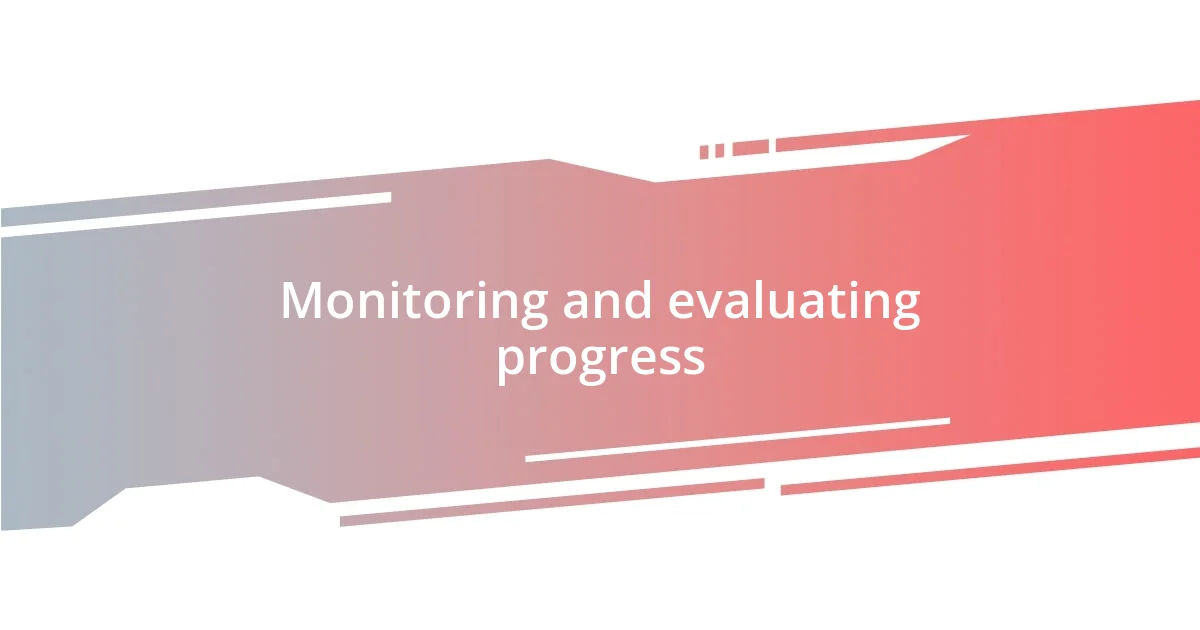
Monitoring and evaluating progress
Monitoring and evaluating progress is essential on this journey toward reducing food waste. One practice I found profoundly impactful was keeping a simple food journal. Each week, I jot down what ingredients I frequently toss out or forget about. Do you realize how eye-opening it can be to see your waste in black and white? I was amazed at how often I let fruits languish in the back of the fridge. This habit not only kept me accountable but also encouraged me to think critically about my purchasing decisions.
As I began tracking my food usage, I noticed patterns emerging. For instance, I often overbought certain staples like rice or pasta, thinking I might make a variety of dishes. In reality, I ended up with an overflowing pantry and little motivation to use up those items. I can’t tell you how liberating it was to set a goal to use up two of my least consumed items each week. This kind of focused evaluation transformed my cooking habits and brought renewed creativity into my meals. Have you ever thought about how an ordinary pantry item could inspire a culinary masterpiece?
Regular check-ins also allowed me to celebrate my small victories. I started a monthly “waste report” where I assess what I saved from the trash and recognize my efforts. There’s a real sense of pride in tracking the reductions and highlighting success stories, like when I turned leftover beans into a delicious dip that my friends adored. Isn’t it rewarding to realize that not only are we making a difference, but we’re also feeding our loved ones scrumptious meals? Embracing this monitoring process turned a daunting task into a celebration of creativity and resourcefulness, making the journey to reduce food waste fulfilling and enjoyable.

Sharing success and inspiring others
Finding joy in sharing my successes has been one of the most rewarding parts of this journey. I remember hosting a small dinner party where I showcased a meal entirely made from leftover ingredients. As I served my friends a vibrant stir-fry using nearly forgotten veggies from my fridge, I noticed how intrigued they were. I couldn’t help but ask, “Can you believe this came from what I almost tossed out?” Their delight and curiosity sparked conversations that inspired others to rethink their cooking practices, turning a simple meal into a catalyst for change.
When I first began to share my experiences online, I was surprised by the response. I posted a simple photo of a zero-waste meal and included my thoughts on reducing food waste. Soon enough, my inbox was flooded with messages of encouragement and shared stories from people trying to adopt similar practices. It really hit me when someone wrote, “You’ve saved my one and only wilting zucchini!” Seeing how my journey resonated with others was incredibly fulfilling. Have you ever considered how your own experiences might inspire someone else to embrace sustainable habits?
In my local community, I started a monthly food swap where we exchange items we no longer need. This little initiative not only reduces waste but also fosters connections among neighbors who otherwise might never have crossed paths. I still remember the excitement of swapping my extra bags of flour for a jar of homemade jam. Each exchange became a powerful reminder that together, we can maximize resources and minimize waste. Isn’t it amazing how sharing our successes can create a ripple effect, inspiring others to join in on the movement?










